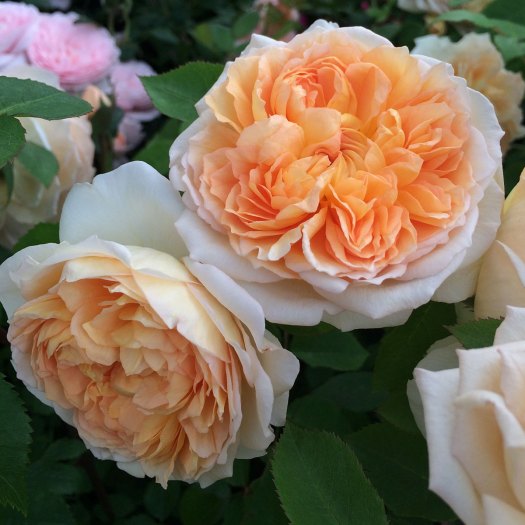
My sweetheart uses the term ‘mannerly climber’ to describe a rose that will climb rather than swamp any structure provided for it by human carers: if the rose produces a succession of elegant, petal-packed rosettes, that’s so much more courteous of it. Rosa ‘Bathsheba’ is a fine example of a mannerly climbing rose.
Pictures rarely tell the full tale of any plant, particularly not a rose. We miss out on the fragrance (strong, flowery myrrh, since you ask) and find it hard to judge the size of the flowers. These are large ones, with a hint of a button eye that becomes Bathsheba very well.

As you’ll see here, the rich apricot colour gradually softens and yellows as the flower matures.
A trellis, wall, tall fence, obelisk or pillar will display Rosa ‘Bathsheba’ to its best advantage.
Part of the preparation for any flower show is to produce neat labels – the judges have been known to deduct marks if some are missing, or so the rumour goes. I try to remember to take a picture of the label as well as the plant, but rarely share them.

I’ve often wondered whether everyone would understand that ‘Clg’ after a rose name means that the rose is a climber. Perhaps it is self-explanatory.
Every protected plant has a code-type appellation – the legal plant name. Being familiar with the minefield that is rose naming, from its earliest days, my website has carried a blanket statement to record that many plants are protected by patents and/or trademarks and to refer all questions about protection of specific varieties to the breeder’s websites.
Most gardeners ignore the appellation but by doing so, they’re sometimes missing a secret, hidden in plain sight. It’s not just a reliable way to identify the breeder: some English Roses have quirky appellations that will raise a smile of recognition or a groan.
Austin roses always start with Aus, a short code for the breeder. The appellation for Rosa ‘Bathsheba’ is Auschimbley, the second half of the code ‘chimbley’ suggesting that Bathsheba has always showed a propensity to climb, or grow like a chimney, chimbley being a dialect form of the word.
Other character-type appellations include Aushedge (R. ‘Wild Edric’), Austough (R. ‘Rosemoor’), Ausglobe (R. ‘Brother Cadfael’ has globe shaped flowers) and Aussemi (R. ‘The Herbalist’ is a semi-double).

So far so good: what’s the secret? Groan-inducing appellations include Auswife (R. ‘The Wife Of Bath’ – housewife); Ausencart (R. Benjamin Britten’ – horse and cart); Auschestnut (R. ‘St. Alban’); Ausky (R.’Mistress Quickly’); Auspishus (R. ‘Janet’), etc.
There is even an Ausufo (R. ‘Comtes de Champagne’).

Are these recent photos? Roses round here are pretty much past their sell-by dates.
They were taken in July, last year, at the Hampton Court Flower Show.
Ah, all is revealed!
My favourite roses are the detailed old fashioned ones. Just beautiful.
Mine too.
Auspishus takes the cake, as my grandma would say. I don’t know which is better, the glorious rose or the lesson on nomenclature. Minefield indeed! But so interesting — thank you!
It devours the cake.
I’ve not seen roses like these, so thickly and tightly packed with petals. Had I been asked what they were I might have said double peonies. Such gorgeous flowers.
They are often mistaken for peonies, and vice versa.
This is lovely. Rather like our Crown Princess Margareta. I liked you fun with puns
It seems so, with a less formal rosette shape and larger flowers.
Mannerly but beautiful!
A truly voluptuous rose.
Wonderful explanation of the names – and some of the last ones are so funny!
I equate Ausky with husky, but that one might just be in my imagination.
Beautiful roses!
Thanks, Correne.
Thank you for the educational and fun insight into labeling and nomenclature. I would not have guessed “clg”! (And, oh yes, the roses are gorgeous!)
My pleasure. I am sure you’re not alone in finding clg a puzzle.
Wow, what a beauty that is too! I love it! I had Leander in my garden once, and then had to move. Never been able to get it back (yet), haha. But…. this one…. wow… it’s like a mix between Eglantyne, Evelyn and Leander or something. Absolutely stunning!
It reminds me of several others too, Tea Clipper for example, although each does have its own character.